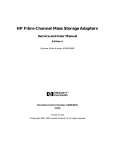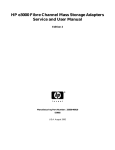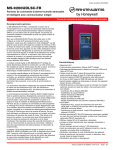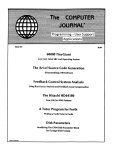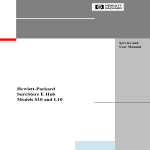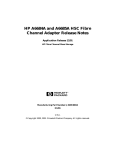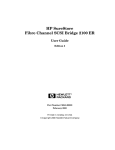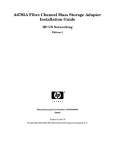Download HP 11i User's Manual
Transcript
HP Fibre Channel Mass Storage Adapters Support Guide FibrChanl-02 (fclp) Driver HP-UX 11i v2 and 11i v3 HP Part Number: J4301-90007 Published: March 2008 Edition: Edition 1 © Copyright 2008 Hewlett Packard Development Company L.P Legal Notices The information in this document is subject to change without notice. Hewlett-Packard makes no warranty of any kind with regard to this manual, including, but not limited to, the implied warranties of merchantability and fitness for a particular purpose. Hewlett-Packard shall not be held liable for errors contained herein or direct, indirect, special, incidental or consequential damages in connection with the furnishing, performance, or use of this material. Warranty A copy of the specific warranty terms applicable to your Hewlett-Packard product and replacement parts can be obtained from your local Sales and Service Office. U.S. Government License Proprietary computer software. Valid license from HP required for possession, use or copying. Consistent with FAR 12.211 and 12.212, Commercial Computer Software, Computer Software Documentation, and Technical Data for Commercial Items are licensed to the U.S. Government under vendor's standard commercial license. Trademark Notices UNIX® is a registered trademark in the United States and other countries, licensed exclusively through The Open Group. Table of Contents 1 Adapter Overview.......................................................................................................11 HP Fibre Channel Mass Storage Overview..........................................................................................11 2 Fibre Channel Adapter Installation............................................................................13 Prerequisites..........................................................................................................................................13 Installing Driver Software.....................................................................................................................13 Installing Adapter Hardware................................................................................................................14 Installing the Fibre Channel Adapter..............................................................................................15 Attaching the Adapter to Other Fibre Channel Devices......................................................................16 Verifying the Fibre Channel Adapter Installation................................................................................16 Verifying Connectivity..........................................................................................................................17 Interpreting Hardware Paths................................................................................................................18 3 Troubleshooting and Maintenance............................................................................21 Introduction..........................................................................................................................................21 Adapter LED States...............................................................................................................................21 Obtaining Card Information after Installation.....................................................................................21 HP Support Tools Manager..................................................................................................................23 Event Monitoring Service.....................................................................................................................24 Fibre Channel Adapter Monitor......................................................................................................24 Supported Products.........................................................................................................................24 Installing and Configuring Support Tools Manager and EMS.......................................................25 System requirements:.................................................................................................................25 Procedure...................................................................................................................................25 Offline Diagnostics Environment (ODE)..............................................................................................25 Diagnostic Flowcharts...........................................................................................................................26 .........................................................................................................................................................2 6 Flowchart 1: Configuration Test Procedures..............................................................................27 Fibre Channel Connections Test......................................................................................................28 Flowchart 2 Connections Test Procedures.................................................................................29 .........................................................................................................................................................2 9 Flowchart 3: Boot Test Procedures.............................................................................................30 Firmware Updates................................................................................................................................30 Fibre Channel Host Bus Adapter Online Firmware Updates.........................................................30 Fibre Channel Host Bus Adapters Offline Driver and Firmware Updates.....................................30 Preparing to Update...................................................................................................................30 Updating the Firmware..............................................................................................................30 Fibre Channel Device Scanning Policy Configuration for HP Integrity Systems................................31 Modifying the Scanning Policy........................................................................................................31 A Regulatory Statements.................................................................................................33 Regulatory Statements..........................................................................................................................33 FCC Statement (USA Only).............................................................................................................33 IEC Statement (Worldwide).............................................................................................................33 DOC Statement (Canada)................................................................................................................33 Spécification ATI Classe A (France)................................................................................................33 VCCI Statement (Japan)..................................................................................................................34 Laser Safety Statements........................................................................................................................34 Table of Contents 3 Certification and Classification Information...................................................................................34 Product Information........................................................................................................................34 Usage Restrictions......................................................................................................................34 Laser Safety (Finland) LASERTURVALLISUUS.............................................................................35 B Technical Specifications...............................................................................................37 AD299A Technical Specifications.........................................................................................................37 AD355A Technical Specifications.........................................................................................................38 Index.................................................................................................................................39 4 Table of Contents List of Figures 3-1 3-2 3-3 A-1 A-2 Flowchart 1: Configuration Test....................................................................................................26 Flowchart 2: Fibre Channel Connections Test...............................................................................28 Flowchart 3: Boot Test...................................................................................................................29 Japanese VCCI Statement..............................................................................................................34 Class 1 Laser Label........................................................................................................................34 5 6 List of Tables 2-1 2-2 2-3 3-1 B-1 B-2 Fibre Channel Adapter Bundle and Product Names....................................................................13 Cable Products...............................................................................................................................16 Hardware Path Field Descriptions................................................................................................18 AD299A/AD355A LED Interpretation Table.................................................................................21 .......................................................................................................................................................3 7 .......................................................................................................................................................3 8 7 8 List of Examples 2-1 2-2 Hardware Path for a Direct Fabric Attach Device.........................................................................18 Hardware Path for a Private Loop Device....................................................................................18 9 10 1 Adapter Overview This manual contains information about HP Fibre Channel Mass Storage Host Bus Adapters that use the fclp driver. Each adapter is identified along with installation and troubleshooting instructions. This chapter addresses the following topic: “HP Fibre Channel Mass Storage Overview” (page 11) HP Fibre Channel Mass Storage Overview NOTE: For the latest copy of this document and related HP Fibre Channel documentation: 1. Go to http://www.docs.hp.com 2. In the “Internet & Networking” category, select “I/O Cards and Networking Software”. 3. Select “Fibre Channel”. HP Fibre Channel Mass Storage is a high-speed connection for mass storage. It transmits data faster than existing SCSI mass storage interconnects. HP Fibre Channel Mass Storage networks are ideal for data-intensive applications, including data mining, atmospheric modeling, multimedia, geographic information systems, and medical imaging. HP Fibre Channel host bus adapters (HBAs) are available for HP/9000 and HP Integrity servers. For all supported configurations, see the HP Fibre Channel Host Bus Adapter Support Matrix at: http://www.docs.hp.com Installation steps differ for various systems. Be sure to follow the information in this guide for your adapter. See the system’s documentation for detailed installation procedures and illustrations. HP Fibre Channel Mass Storage Overview 11 12 2 Fibre Channel Adapter Installation This chapter contains installation prerequisites, guidelines, and procedures for each host bus adapter. This chapter addresses the following topics: “Prerequisites” (page 13) “Installing Driver Software” (page 13) “Installing Adapter Hardware” (page 14) “Attaching the Adapter to Other Fibre Channel Devices” (page 16) “Verifying the Fibre Channel Adapter Installation” (page 16) “Verifying Connectivity” (page 17) “Interpreting Hardware Paths” (page 18) Prerequisites Before installing the adapter, follow these steps: 1. 2. Verify compliance with supported configurations using the HP Fibre Channel Host Bus Adapter Support Matrix at: http://docs.hp.com/en/netcom.html#Fibre%20Channel Determine if the adapter is a Customer Replaceable Unit (CRU) using the HP Fibre Channel Host Bus Adapter Support Matrix. If the adapter is not a CRU, contact your HP representative for installation assistance. Field Replaceable Units (FRUs) must be installed or replaced by qualified Hewlett-Packard service representatives only. CRUs can be installed or replaced by customers or qualified Hewlett-Packard service representatives. 3. Check the following conditions: • To verify that the/usr/bin, /usr/sbin, and /sbin directories are in the PATH, enter the following command: echo $PATH • Verify that you have the following items: — Grounding wrist strap — Fibre Channel driver software media (included with the OS or application CD or DVD) — Fibre Channel host bus adapter with an optical port protector attached (not included with all adapters) • Verify that you have the following cabling items: — Fiber optic cable terminated with a duplex LC connector. — Cable map (optional) Installing Driver Software These instructions apply to software installation for the following configurations: • • AD299A Fibre Channel Adapter with HP-UX 11i v2 and 11i v3 AD355A Fibre Channel Adapter with HP-UX 11i v2 and 11i v3 Table 2-1 (page 13) lists the bundle and product name for each adapter. Table 2-1 Fibre Channel Adapter Bundle and Product Names Adapter OS Version Software Bundle Software Name Driver AD299A 11i v2 and 11i v3 FibrChanl-02 FC-FCLP fclp AD355A 11i v2 and 11i v3 FibrChanl-02 FC-FCLP fclp Prerequisites 13 Additional HBAs may be supported; see the HP-UX Fibre Channel (fcd and fclp) Host Bus Adapter Support Matrix at http://docs.hp.com/en/netcom.html#Fibre%20Channel for the most current information on supported products. To install the software bundle, follow these steps: 1. 2. 3. Log in to the system as root. Insert the CD or DVD into the drive. Mount the CD using the following command: mount /dev/dsk/<cd_rom_dev_file> /<tmp_mnt> 4. Run swinstall to install the software. Enter the following command: /usr/sbin/swinstall The Software Selection window and the Specify Source window open. 5. In the Specify Source window, change the Source Host Name if necessary. Enter the mount point of the drive in the Source Depot Path field and click OK to return to the Software Selection window. Click Help to get more information. 6. 7. 8. 9. Select the appropriate software bundle for your adapter. Select Mark for Install from the Actions menu. Select Install from the Actions menu. Installation begins and the Install Analysis window opens. Click OK in the Install Analysis window to confirm that you want to install the software. The Install window opens. View the Install window to read processing data while the software installs. When the Status field indicates Ready, the Confirmation window opens. 10. 11. 12. 13. Click OK. A second Confirmation window opens. Click OK again. The Install window opens. Click Done. The Note window opens. Click OK in the Note window to reboot. The user interface disappears and the system reboots. 14. Once the system comes back up, log in as root and open the following files to see any error or warning messages that may have occurred during the installation: /var/adm/sw/swagent.log /var/adm/sw/swinstall.log 15. Install OnlineDiag, which is available at http://www.software.hp.com. OnlineDiag is also available from the HP Support PLUS CD. Installation instructions are available at: http://docs.hp.com/hpux/onlinedocs/diag/st/st_inst.htm Installing Adapter Hardware The Online Addition and Replacement feature, OL* for the HP-UX 11i v3 release, enables PCI host bus adapters to be added or replaced without shutting down and rebooting the system, and without adversely affecting other system components. The system hardware uses slot-specific power control, combined with HP-UX operating system support, to enable these features. 14 Fibre Channel Adapter Installation NOTE: HP-UX 11i v3 does NOT support Online Deletion (OLD) with fclp. NOTE: HP-UX 11i v2 supports Online Addition (OLA) ONLY with fclp. It does NOT support Online Replacement (OLR) or Online Deletion (OLD). Confirm whether OL* is supported on the system in which you plan to install a Fibre Channel adapter. See the HP Fibre Channel Host Bus Adapter Support Matrix, at: http://docs.hp.com/en/netcom.html#Fibre%20Channel For detailed instructions on using OL* on HP-UX 11i v2 , 11i v3, and later HP-UX releases, see the Interface Card OL* Support Guide and the Interface Card OL* Support Matrix at: http://docs.hp.com/en/hpux11iv2.html IMPORTANT: Superdome systems are not intended to be maintained by customers. HP recommends that Superdome systems only be opened by a qualified HP service engineer. Failure to observe this recommendation can invalidate any support agreement or warranty to which you may be entitled. Installing the Fibre Channel Adapter CAUTION: Observe all ESD safety precautions before attempting this procedure. Failure to follow ESD safety precautions could result in damage to equipment. NOTE: The optical port protector is used only to protect the adapter port when it is not in use. Do not use the protector as a diagnostic tool. Install OnlineDiag, which is available at: http://www.software.hp.com OnlineDiag is also available from the HP Support PLUS CD for HP/9000 systems or the IPF CD for Itanium systems. Installation instructions are available at: http://docs.hp.com/hpux/onlinedocs/diag/st/st_inst.htm Install all driver software and dependent patches before you install the adapter. For more information, see FibrChanl-02 (fclp) Fibre Channel Mass Storage Driver for HP-UX 11i v2 Release Notes available at: http://docs.hp.com/en/netcom.html#Fibre%20Channel NOTE: See the system documentation for information about how to safely shut down your system and obtain access to expansion slots. To install the Fibre Channel adapter, follow these steps: NOTE: With HP-UX 11i v2, be sure to check that you are installing the card in a non-switched slot. If you install the card in a switched slot, you will see the following error message: fclp ifc_attach: HBA installed in unsupported slot If you see this message, you must shut down the system, remove the card, and re-install it in a non-switched PCIe slot. Refer to the server documentation for instructions on how to identify a non-switched PCIe slot. 1. 2. 3. 4. Install all driver software and dependent patches. Shut down the system. Insert the card into the highest-performance PCIe slot available. Attach fiber cabling to the adapter. All Fibre Channel host bus adapters that use the fclp driver use a cable terminated with an LC connector. Installing Adapter Hardware 15 Attaching the Adapter to Other Fibre Channel Devices To attach the adapter to other Fibre Channel devices, follow these steps: 1. 2. Remove the Fibre Channel host bus adapter’s optical port protector (if included). Attach a connector cable to the Fibre Channel host bus adapter. a. Align the slotted plug with the keyed connector. b. Push the connector in until you hear it click. 3. 4. Attach the free end of the cable to a compatible Fibre Channel device. Reconnect the power cord, if necessary, and power on the system. Table 2-3 lists the Fibre Channel cables that you can use when connecting devices to Fibre Channel host bus adapters. Table 2-2 Cable Products LC-LC 221692-B21 Fibre Channel Cable 2m LC-LC 50/125 Duplex 221692-B22 Fibre Channel Cable 5m LC-LC 50/125 Duplex M/M 221692-B23 Fibre Channel Cable 15m LC-LC 50/125 Duplex M/M 221692-B26 Fibre Channel Cable 30m LC-LC 50/125 Duplex M/M 221692-B27 Fibre Channel Cable 50m LC-LC 50/125 Duplex M/M LC-SC 221691-B21 Fibre Channel Cable 2m LC-SC 50/125 Duplex M/M 221691-B23 Fibre Channel Cable 15m LC-SC 50/125 Duplex M/M SC-SC 234457-B23 Fibre Channel Cable 15m SC-SC 50/125 Duplex M/M NOTE: Be sure to use LC-LC or LC-SC cables for the Fibre Channel host bus adapters which use the fclp driver. Verifying the Fibre Channel Adapter Installation To verify that your Fibre Channel Adapter has been correctly installed, follow these steps: 1. Enter the following command: ioscan -f 2. Verify that the correct drivers appear for each installed adapter. If all drivers display, proceed to the next section, “Verifying Connectivity” (page 17). Sample ioscan output: ba 3 0/3 ba 4 0/3/0/0 fc 3 0/3/0/0/0/0 Fibre Channel Adapter gh2p PCItoPCI fclp /dev/fclp3 fcp 3 0/3/0/0/0/0.1 fclp_fcp ext_bus 134 0/3/0/0/0/0.1.27.255.13 target 17 0/3/0/0/0/0.1.27.255.13.3 disk 236 0/3/0/0/0/0.1.27.255.13.3.0 Port 2: fc 5 0/3/0/0/0/1 fclp Fibre Channel Adapter /dev/fclp5 fcp 0 0/3/0/0/0/1.1 fclp_fcp ext_bus 138 0/3/0/0/0/1.1.27.255.13 target 3 0/3/0/0/0/1.1.27.255.13.3 disk 248 0/3/0/0/0/1.1.27.255.13.3.0 16 Fibre Channel Adapter Installation CLAIMED CLAIMED CLAIMED BUS_NEXUS BUS_NEXUS INTERFACE Local Bus Adapter PCItoPCI Bridge HP AD355-60001 4Gb PCIe 2-port CLAIMED fclp_vbus tgt sdisk INTERFACE CLAIMED CLAIMED CLAIMED FCP Domain INTERFACE DEVICE DEVICE CLAIMED INTERFACE HP AD355-60001 4Gb PCIe 2-port CLAIMED fclp_vbus tgt sdisk INTERFACE CLAIMED CLAIMED CLAIMED FCP Domain INTERFACE DEVICE DEVICE FCP Device Interface HPQ BF03658242 FCP Device Interface HPQ BF03658242 /dev/dsk/c138t3d0 /dev/rdsk/c138t3d0 NOTE: The third column represents the hardware path of the slot in which the adapter is installed. The hardware path is different for each installed adapter. If an installed Fibre Channel adapter requires the fclp driver and the appropriate driver does not appear as shown above, the driver is not installed. If the ioscan output is similar to the following: fc 0/0/2/1/0 UNCLAIMED UNKNOWN HP-UX detected the adapter, but the drivers are not properly loaded. If the correct driver is installed, but the adapter does not show in the ioscan output, the driver is not recognizing the adapter. 3. If the ioscan output indicates a problem, contact HP for assistance. Verifying Connectivity Once your HP Fibre Channel Mass Storage software and hardware are installed and running, follow these steps to verify connectivity: 1. Check the state of all Fibre Channel hardware and interfaces. Enter the ioscan command and verify that the Hardware State and the HW-Interface State are CLAIMED. If the Fibre Channel device file has not been created, enter the following commands: # insf -e # ioscan -f 2. Verify that all devices you attached to the Fibre Channel adapter are listed in the ioscan output. For example, if you have a direct attach Fibre Channel device attached to the system, the ioscan output may look like the following: 8/12.8.0.255.0.1.0 sdisk CLAIMED DEVICE DGC C3400WDR5 The example above is the hardware path of LUN0 of a directly attached Fibre Channel Mass Storage device with Loop ID of 1. For details on interpreting hardware paths for Fibre Channel devices, see “Interpreting Hardware Paths” (page 18). If all attached devices are not listed or appear as UNCLAIMED, see the Troubleshooting and Maintenance chapter of this guide. Verifying Connectivity 17 Interpreting Hardware Paths Examples 2-1 and 2-2 illustrate the Fibre Channel hardware path format: Example 2-1 Hardware Path for a Direct Fabric Attach Device Adapter Domain Area Port Bus Target LUN 0/1/2/0.1.19.255.0.0.0 Example 2-2 Hardware Path for a Private Loop Device Adapter Domain Area Port Bus Target LUN 0/1/2/0.8.0.255.0.1.0 Table 2-3 describes each field in the hardware path. Table 2-3 Hardware Path Field Descriptions Fibre Channel Topology of HBA Field Value Fabric Topologies Private Loop Adapter The hardware path of the Fibre Channel adapter through which the Logical Unit Number (LUN) is seen. For multiport adapters, this field describes a specific port on the adapter. Domain Dependent on the Fibre Typically the Domain ID of the switch to Channel topology of the which the target device is attached, taken HBA. from the most significant byte of the N_Port ID of the target device. Area Depends on the Fibre Taken from the second byte of the N_Port 0 Channel topology of the ID of the target device. On some HBA. switches, the second byte of the N_Port ID encodes the switch port to which the device is connected. The encoding method depends on the switch. See your switch manual to interpret this field. Port Depends on the Fibre Channel topology of the HBA and the target device, and on the LUN addressing method used. Bus 18 Depends on the Fibre Channel topology of the HBA and the target device, and on the LUN addressing method used. Fibre Channel Adapter Installation 8: HP-UX uses a Domain ID of 8 to indicate private loops. Fibre Channel switches seen by HP-UX hosts cannot be configured with domain ID of 8. For LUNs with Peripheral Device Addressing, the value of this field is always 255. For other LUN methods, the value of this For other LUN methods, the value of field is the least significant byte of the this field is the Loop ID of the target N_Port ID of the target device. device. For LUNs with Peripheral Device Addressing, the value of this field is the upper 4 bits of the least significant byte of the N_Port ID of the target device. For LUNs with Peripheral Device Addressing, the value of this field is the upper 4-bits of the Loop ID of the target device. For LUNs with Logical Unit Addressing, the value is the Bus Number field of the LUN. For LUNs with Volume Set Addressing (Flat Space Addressing), the value is bits 7 - 13 of the LUN. Table 2-3 Hardware Path Field Descriptions (continued) Fibre Channel Topology of HBA Field Target Value Depends on the Fibre Channel topology and the LUN addressing method used. Fabric Topologies Private Loop For LUNs with Peripheral Device Addressing, the value of this field is the lower 4-bits of the third byte of the N_Port ID of the target device. This field usually corresponds to the Arbitrated Loop Physical Address (AL_PA) of the target device. With Peripheral Device Addressing, the value of this field is the lower 4-bits of the Loop ID of the target device. For LUNs with Logical Unit Addressing, the value is the Target field of the LUN. For LUNs with Volume Set Addressing (Flat Space Addressing), the value is bits 3 - 6 of the LUN. LUN Depends only on the LUN addressing method used. LUN Addressing Method Peripheral Device Addressing Logical Unit Addressing Volume Set Addressing (Flat Space Addressing) Value of LUN field in Fibre Channel hardwarePath. The Target or LUN field of the Logical Unit Number. The LUN field of the Logical Unit Number. Bits 0 - 2 of the Logical Unit Number. For more information about the fields in the Logical Unit Number, please see the SCSI Architecture Model - 3 (SAM-3) standards document. Interpreting Hardware Paths 19 20 3 Troubleshooting and Maintenance This chapter describes the troubleshooting and maintenance tools available for Fibre Channel Mass Storage adapters. This chapter addresses the following topics: “Introduction” (page 21) “Adapter LED States” (page 21) “Obtaining Card Information after Installation” (page 21) “HP Support Tools Manager” (page 23)??? “Event Monitoring Service” (page 24) “Offline Diagnostics Environment (ODE)” (page 25) “Diagnostic Flowcharts” (page 26) “Firmware Updates” (page 30) “Fibre Channel Device Scanning Policy Configuration for HP Integrity Systems” (page 31) Introduction Troubleshooting Fibre Channel problems can involve a variety of hardware and software components. A problem affecting the system may originate in another part of the Fibre Channel Mass Storage interconnect. If you cannot solve the problem on your own, contact your HP representative. Adapter LED States The Fibre Channel Mass Storage Adapter status LEDs indicate the state of the adapter. Table 3-1 lists the different LED states for the adapter. Table 3-1 AD299A/AD355A LED Interpretation Table Yellow LED Green LED HBA State 1 Blink ON Normal Operation (1 Gb link rate, link up) 2 Blinks ON Normal Operation (2 Gb link rate, link up) 3 Blinks ON Normal Operation (4 Gb link rate, link up) OFF Slow blink Normal (link down or not started) OFF OFF Slot Not Powered, or Adapter Card Initialization Failure ON OFF POST Failure (dead board) Slow blink OFF Wake-Up Failure Monitor Fast blink OFF POST Failure Flashing OFF POST Process in Progress OFF ON Failure While Functioning ON ON Failure While Functioning Slow blink Slow blink Offline for Download Fast blink Slow blink Restricted Offline Mode (waiting for restart) Flashing Slow blink Restricted Offline Mode (test active) Obtaining Card Information after Installation Example of Card information after Installation AD355A: fcmsutil /dev/fclp# Vendor ID is = 0x10df Introduction 21 Device ID is = 0xfe00 PCI Sub-system Vendor ID is = 0x103c PCI Sub-system ID is = 0x7049 Chip version = 2 Firmware Version = 2.70A5 SLI-3 (Z3F2.70A5) Driver-Firmware Dump Available = NO Driver-Firmware Dump Timestamp = N/A Topology = PTTOPT_FABRIC Link Speed = 4Gb Local N_Port_id is = 0x011900 Previous N_Port_id is = None N_Port Node World Wide Name = 0x50060b0000fd7521 N_Port Port World Wide Name = 0x50060b0000fd7520 Switch Port World Wide Name = 0x201900051e02ed2e Switch Node World Wide Name = 0x100000051e02ed2e Driver state = ONLINE Hardware Path is = 0/3/0/0/0/0 Maximum Frame Size = 2048 Driver Version = @(#) FCLP: PCIe Fibre Channel driver (FibrChanl-02), B.11.23.0706, Apr 10 2007, IFC (1,1 AD299A: fcmsutil /dev/fclp# Vendor ID Device ID PCI Sub-system Vendor ID PCI Sub-system Chip Revision ID Firmware Version Driver-Firmware Dump Available Driver-Firmware Dump Timestamp Hardware Path Topology Link Speed Local N_Port_id Previous Local N_Port_id N_Port Node World Wide Name N_Port Port World Wide Name Switch Port World Wide Name Switch Node World Wide Name Driver state Driver Version Channel driver (FibrChanl-02), B.11.23.0706, = 0x10DF = 0xFE00 = 0x103C = 0x7046 = 0x2 = 2.70X3 SLI-3 (Z3D2.70X3) = NO = N/A = 2/0/4/0/0/0/0 = PTTOPT_FABRIC = 4Gb = 0x018500 = None = 0x50060B0000FD614B = 0x50060B0000FD614A = 0x208500051E360C30 = 0x100000051E360C30 = ONLINE = @(#) FCLP: PCIe Fibre April 10 2007, IFC (1,1) This card is capable of running at bus speeds up to PCIe x4 link width. The actual link width is displayed as the PCI Mode. Example of Vital Product Data (VPD) after installation AD355A: fcmsutil /dev/fclp# vpd *********************************************************************** **** Vital Product Data **** *********************************************************************** Product Description : "HP AD355A PCIe 2-port 4Gb Fibre Channel HBA" Part number : "AD355-60001" Part Serial number : "JP47201135" Engineering Date Code : "A-4718" Mfd. Date : "4720" Misc. Information : "PW=10W; PCIe x4 Gen1" ROM Firmware version : "2.70X3 SLI-3 (Z3D2.70X3)" AD299A: *********************************************************************** **** Vital Product Data **** *********************************************************************** Product Description : "HP AD299A PCIe 1-port 4Gb Fibre Channel HBA" Part number : "AD299-60001" Part Serial number : "JP47210016" Engineering Date Code : "A-4718" Mfd. Date : "4721" Misc. Information : "PW=7.5W; PCIe x4 Gen1" ROM Firmware version : "2.70X3 SLI-3 (Z3D2.70X3)" Example of ioscan entry after installation fc 0 0/2/0/0/0/0 fclp CLAIMED INTERFACE HP AD299-60001 4Gb PCIe 1-port Fibre Channel Adapter fcp 1 0/2/0/0/0/0.108 fclp_fcp CLAIMED INTERFACE FCP Domain ext_bus 3 0/2/0/0/0/0.108.11.0.0 fclp_vbus CLAIMED INTERFACE FCP Array Interface target 15 0/2/0/0/0/0.108.11.0.0.1 tgt CLAIMED DEVICE disk 20 0/2/0/0/0/0.108.11.0.0.1.1 sdisk CLAIMED DEVICE HP MSA VOLUME 22 Troubleshooting and Maintenance disk 21 0/2/0/0/0/0.108.11.0.0.1.2 sdisk CLAIMED DEVICE HP MSA VOLUME disk 22 0/2/0/0/0/0.108.11.0.0.1.3 sdisk CLAIMED DEVICE HP MSA VOLUME disk 23 0/2/0/0/0/0.108.11.0.0.1.4 sdisk CLAIMED DEVICE HP MSA VOLUME disk 24 0/2/0/0/0/0.108.11.0.0.1.5 sdisk CLAIMED DEVICE HP MSA VOLUME disk 25 0/2/0/0/0/0.108.11.0.0.1.6 sdisk CLAIMED DEVICE HP MSA VOLUME disk 26 0/2/0/0/0/0.108.11.0.0.1.7 sdisk CLAIMED DEVICE HP MSA VOLUME target 16 0/2/0/0/0/0.108.11.0.0.2 tgt CLAIMED DEVICE disk 27 0/2/0/0/0/0.108.11.0.0.2.0 sdisk CLAIMED DEVICE HP MSA VOLUME disk 28 0/2/0/0/0/0.108.11.0.0.2.1 sdisk CLAIMED DEVICE HP MSA VOLUME disk 29 0/2/0/0/0/0.108.11.0.0.2.2 sdisk CLAIMED DEVICE HP MSA VOLUME target 17 0/2/0/0/0/0.108.11.0.0.3 tgt CLAIMED DEVICE disk 30 0/2/0/0/0/0.108.11.0.0.3.6 sdisk CLAIMED DEVICE HP MSA VOLUME ext_bus 4 0/2/0/0/0/0.108.11.255.0 fclp_vbus CLAIMED INTERFACE FCP Device Interface target 14 0/2/0/0/0/0.108.11.255.0.0 tgt CLAIMED DEVICE ctl 2 0/2/0/0/0/0.108.11.255.0.0.0 sctl CLAIMED DEVICE HP MSA CONTROLLER HP Support Tools Manager This section describes how to use HP Support Tools Manager (STM) to gather information about the Fibre Channel adapters, diagnose problems, and update firmware. STM runs in three modes: • Menu Mode Use the mstm command to start STM in Menu Mode. • X Windows environment Use the xstm & command to start STM in X Windows. • Command Line Mode Use the cstm command to start STM in Command Line Mode. Three tools are available in STM for Fibre Channel Mass Storage adapters: • Information Tool The Information Tool provides information about a Fibre Channel adapter without resetting the adapter. The following is an example information log: Log creation time: Tue Jun 6 14:12:23 2000 Hardware path: 8/12 Product ID: Hardware Path: Module Type: Hardware Model: Hardware Revision Number: Software Revision Number: Software Model Number: Software Option: Hard Physical Address: Slot Number: IODC Revision: World Wide Name: Date Code: • Fibre Channel Interface 8/12 Type-A DMA I/O 0x15 0 0 0xa7 0x80 0xffb4c000 3 0 1000080009F64883 3822 Logtool Utility The Logtool Utility extracts log errors and enables you to view them. This tool provides information about a Fibre Channel adapter without resetting the adapter. The following is an example utility log: Log creation time: Mon Sep 11 17:47:07 2000 Device Path : 8/12 Product ID: Fibre Channel Interface Product Qualifier: 15 Logger: td HP Support Tools Manager 23 Device Type: Interface Device Qualifier: Fibre ----------------------------------------------------------Severity Level: Error 1Bolt Value: 88417 Error 17: The Fibre Channel Driver received a LINK DOWN interrupt. Additional Information: Frame Manager Status Register = 0x1 Received AL_PA Register = 0x2 Loss of Signal Counter = 3 Bad Received Character Count = 4 Loss of Synchronization Count = 5 Link Failure Count = 6 Received EOF Count = 9 Generated EOF Count = 8 Bad CRC Count = 9 Protocol Error Count = 10 Possible Causes/Recommended Actions: It is possible for link down errors to occur under normal operation. No action is required. The system will recover. • Diagnose Tool The Diagnose Tool runs a loopback test on a Fibre Channel adapter. This test is destructive and must only be run by qualified personnel or on instruction from an HP Support Representative. NOTE: STM also includes a Firmware Update tool. This tool cannot be used to update the firmware on Fibre Channel adapters. Event Monitoring Service Event Monitoring Service (EMS) notifies you when an event occurs on the system. A hardware event monitor monitors the hardware for unusual behavior (known as an event) and sends a message to the EMS, which notifies you of the event and provides suggestions for correcting the problem. This service is available for all of the Fibre Channel host bus adapters. Fibre Channel Adapter Monitor The Fibre Channel Adapter Monitor monitors the operation of all supported fibre channel host bus adapter cards on your system. If the monitor detects a problem with any of the adapters, it immediately sends an event to EMS, which alerts you using the notification methods defined for the monitor. Error messages identify the problem, its cause, and corrective actions. The Fibre Channel Adapter Monitor employs asynchronous event detection. The monitor continuously checks for any errors or abnormal behavior reported by the device driver during I/O operations. If an error occurs, it passes directly to the monitor for immediate analysis. If the error warrants notification, the monitor immediately generates an event. The monitor launches automatically when the system starts, ensuring protection for all supported Fibre Channel adapters from undetected hardware failure. Supported Products The Fibre Channel Adapter Monitor supports the following product: • • 24 AD299A AD355A Troubleshooting and Maintenance Installing and Configuring Support Tools Manager and EMS System requirements: • • • • HP-UX computer (servers or workstations) HP-UX 11i v1, 11i v2, 11i v3, or later HP-UX operating system versions Support Plus Media CD If you are using ServiceGuard (optional), check for the correct version you must have for HP-UX 11i v1, 11i v2, or later HP-UX operating system versions Procedure 1. Install the Support Tools Manager (STM) from the latest Support Plus Media CD. The EMS hardware monitors automatically install when you install STM. a. Enter the following command to see if STM is installed on your system: /usr/sbin/cstmThe message --Information-- Support Tools Manager should appear on your screen, indicating that STM is installed on your system. b. If this does not appear, STM needs to be installed. For instructions on how to install STM see Chapter 5, “Using the Support Plus Media to Install Diagnostics”, in the manual Support Plus: Diagnostics User's Guide, available at: http://docs.hp.com/diag/index.html 2. Examine the list of supported products to see if any of your devices have special requirements to be monitored. Add or modify monitoring requests to customize the monitoring configuration for your system. (Recommended) Verify that monitors are correctly operating; for example, simulate a hardware failure or event and view the logs. 3. 4. The default hardware monitoring configuration meets most monitoring requirements. By default, messages regarding warning, serious, and critical events are written to /var/adm/syslog/syslog.log and sent to the root e-mail address. All events are also stored in/var/opt/resmon/log/event.log. If you must customize the default monitoring configuration, you can add or modify monitoring requests as needed. Offline Diagnostics Environment (ODE) All HP Fibre Channel adapters support the HP Offline Diagnostics Environment (ODE). ODE is an offline support tools platform for troubleshooting HP/9000 and HP Integrity systems running without an operating system, or systems that cannot be tested using online tools. The offline environment is also useful for testing before a system is booted. ODE provides a user-friendly interface for diagnostics and utilities developed to run in an offline environment. ODE has a distributed architecture consisting of several modules. Each module has a specific function and uses well defined protocols to communicate with the other modules. You can use either the command-line interface or the menu-driven interface. The command-line interface enables you to select tests and utilities to execute on a specific hardware module. The menu-driven interface enables you to specify the hardware module to be tested, then ODE selects the appropriate tests to execute on the module. ODE consists of the following: Test Controller Test Modules Acts as the user interface and launches the execution of the Test Modules. Diagnostic or utility programs designed to execute within ODE. These modules exercise or diagnose user-specified hardware units. Offline Diagnostics Environment (ODE) 25 System Library (SysLib) A set of common routines for use by both the Test Controller and the Test Modules. These routines perform I/O, string parsing, and system control. For more information on ODE, see the Itanium Processor Family (IPF) Offline Diagnostics and Utilities CD Overview at: http://docs.hp.com/en/diag.html#Offline%20Diagnostics Diagnostic Flowcharts The diagnostic flowcharts illustrate the following tests: Flowchart 1: Configuration Test Flowchart 2: Fibre Channel Connections Test Flowchart 3: Boot Test Verifies the configuration of the mass storage interface on a host using the ioscan (1M) command. Checks all hardware connections between your system and Fibre Channel mass storage devices, to confirm that they are connected and operational. Verifies that the system boots correctly over Fibre Channel. See the Support Matrix for the Fibre Channel adapter you are troubleshooting for current system and adapter firmware requirements and other information. Support Matrixes for HP Fibre Channel adapters are available at: http://docs.hp.com/en/netcom.html#Fibre%20Channel Figure 3-1 Flowchart 1: Configuration Test 1 A Enter the ioscan command B HP adapter displayed? C yes Hardware state = CLAIMED? no D G Update System Firmware no Is System Firmware version adequate? Device displayed? yes Enter the swlist command DONE F Reinstall Fibre Channel software no Is the FC FILESET displayed? yes 1 26 Troubleshooting and Maintenance 2 Go to Flowchart 2 4 Go to Flowchart 2 H 1 I 2 yes yes E no On Flowchart 2 no Flowchart 1: Configuration Test Procedures The sections below provide additional detail on the procedures listed in Flowchart 1. A. Enter theioscan command to display information about attached peripherals that are successfully bound to the system; for example, enter /etc/ioscan-f. For more information, see the ioscan manpage. B. HP adapter displayed? The ioscan output displays information about every peripheral adapter in the system backplane. C. Hardware state = CLAIMED? The hardware state is operational if “CLAIMED” displays for the Fibre Channel adapter under the Hardware State heading. If the Fibre Channel adapter is “CLAIMED”, go to H. If the Fibre Channel adapter is not “CLAIMED”, go to number 2 on Flowchart 2. D. Check the Support Matrix for the minimum system firmware version required to support the Fibre Channel adapter in your system, then confirm which system firmware version you have. If the system firmware meets or exceeds the minimum required version, go to E. If not, go to G. E. Enter the swlist command to see if the Fibre Channel Mass Storage filesets have been installed. For example, enter swlist -l fileset. F. Does FC FILESET display? The file sets displayed depend on the Fibre Channel adapter product you are using. An example of file set for the PCI Tachyon TL and XL2 adapters is: FC-TACHYON-TL-FC-TL-KRN and FC-TACHYON-TL-RUN An example file set for the AD299A single port adapter is: FC-FCLP-KERN and FC-FCLP-RUN An example file set for other Fibre Channel adapters is: FCMassStorage.FCMS-KRN and FCMassStorage.FCMS-RUN If the proper FILESET displays, and you still do not see the adapter, the adapter may have a problem. Go to Flowchart 2. If the file sets do not display, proceed to I. G. Update the system firmware. Then go back to number 1 on Flowchart 1. H. Device Displayed? If devices do not display, go to number 4 on Flowchart 2. Diagnostic Flowcharts 27 Fibre Channel Connections Test Figure 3-2 Flowchart 2: Fibre Channel Connections Test 2 A Verify that the FC adapter is properly seated no Reinstall the adapter yes B Adapter problem, Call HP C 4 Verify that the connectors are solidly connected D Verify the connection to the device E Verify that the device is powered on F Run the device diagnostics 1 28 Troubleshooting and Maintenance Go to Flowchart 1 1 Go to Flowchart 1 Flowchart 2 Connections Test Procedures The sections below provide additional detail on the procedures listed in Flowchart 2. A. Verify that the Fibre Channel adapter is properly seated. Shut down the system by entering /usr/sbin/shutdown -h. Power off the system and disconnect the cables. Check that the adapter is properly seated in the backplane. To verify that it is seated correctly, power on the system. B. Adapter problem, call HP. Contact your HP service representative for assistance. C. Verify that the connectors are solidly connected. Without powering off the system, make sure that the connectors on the fiberoptic cable match the keyed connectors on the adapter, and that they are solidly connected. D. Verify the connection to the Fibre Channel Mass Storage device. Make sure the Fibre Channel cable is fully connected to the Fibre Channel Mass Storage device, and the device is operating. Follow the instructions in the device manual to check the device state. Try changing the connection to a different port on the Fibre Channel Mass Storage device, if possible. After checking the connections, go to Flowchart 3. E. Verify that the Fibre Channel Mass Storage device is powered on. If not, power on the device. F. Run Fibre Channel Mass Storage device-specific diagnostics. If diagnostics are available to troubleshoot the Fibre Channel Mass Storage device, follow the steps to verify that the device is functioning properly. After verification, go to Flowchart 3. Figure 3-3 Flowchart 3: Boot Test 3 3 A Is the system bootable over FC? no See the boot device in your system manual yes B Is System Firmware version adequate? C no Update firmware Go to Flowchart 1 yes D Is minimum adapter ROM firmware installed? E no Update adapter 3 1 ROM firmware Go to Flowchart 1 yes F Is minimum adapter EFI version installed? 3 1 G no Update adapter EFI version 3 1 Go to Flowchart 1 3 4 Go to Flowchart 2 Diagnostic Flowcharts 29 Flowchart 3: Boot Test Procedures The sections below provide additional detail on the procedures listed in Flowchart 3. A. Is the system bootable over the Fibre Channel adapter? Only certain systems can boot over the Fibre Channel adapter. If your system cannot do this, you must boot from a SCSI device. B. Is the system firmware version adequate? Check the system firmware version on your system for the minimum required date code for your adapter. If Yes, go to step D; if No, go to step C. C. Update firmware. Update the firmware to the appropriate level. D. Is the minimum required Fibre Channel adapter ROM firmware installed? This step applies to Fibre Channel adapters installed in HP/9000 and HP Integrity systems. If the minimum ROM firmware version (or a later version) is installed, go to 4 on Flowchart 2. If not, go to step E. E. Is the minimum required EFI version for the Fibre Channel adapter installed? This step applies to Fibre Channel adapters installed in HP Integrity systems only. If the minimum EFI version (or a later version) is installed, go to 4 on Flowchart 2. If not, go to step G. Firmware Updates This section explains the process for updating the firmware of your Fibre Channel host bus adapter. Fibre Channel Host Bus Adapter Online Firmware Updates The Fibre Channel host bus adapters that use the fclp driver can be updated while the system is online, using the fcmsutil command. The rom_fw_update option to the fcmsutil command updates the HBA's runtime firmware, and the efi_drv_update option of the fcmsutil command updates the EFI driver. Fibre Channel Host Bus Adapters Offline Driver and Firmware Updates The Extensible Firmware Interface (EFI) is an Itanium-based preboot environment used to update the EFI driver and firmware on the adapter. EFI can be used to update a single adapter port or multiple ports, using the batch mode update. Host bus adapters that use the fclp HP-UX driver use Emulex EFI driver menus for performing the updates. Preparing to Update This procedure assumes that you have obtained a new EFI driver and/or adapter firmware from HP, and have loaded it into an EFI filesystem called fs0. Theefi_cp command can be used to copy files from HP-UX into an EFI partition. It is important to make sure that the EFI filesystem is not attached to the adapter you are about to update. It is often helpful to write down the EFI directory and filename of the firmware file, because you will be required to enter the directory and filename as part of the update. Updating the Firmware 1. To view the Emulex driver handle information, type at the EFI shell prompt: fs0:> drivers A list of drivers is displayed. 2. 3. 30 Write down the driver handle associated with the Emulex SCSI Pass Thru Driver. The first column, labelled DRV, lists the driver handles. Enter the drvcfg -s <driver handle> command. For example, if the driver handle is 20 (your driver handle may be different): fs0: drvcfg -s 20 Troubleshooting and Maintenance 4. 5. 6. 7. 8. Information is displayed, listing all of the HBAs in the system. Your listing will vary depending upon how many HBAs are installed in the system. Using the arrow keys, locate the HBA that you want to configure and select (i.e., highlight) the row and press Enter. Select (i.e., highlight) the Firmware Update option, and press Enter. Choose the option to update a single adapter port, or batch mode to update several adapter ports. Follow the onscreen instructions to complete the update process. Fibre Channel Device Scanning Policy Configuration for HP Integrity Systems Because fibre channel SANs can contain many potential boot devices, it is necessary to use an appropriate EFI device scanning policy, when booting an HP Integrity server which is connected to a SAN. The intent of the device scanning policy is to allow a fibre channel EFI driver to find a fibre channel boot device, yet still allow the scanning process to complete in a reasonable amount of time. Most HP Integrity servers implement default device scanning policies that work well with fibre channel without needing modification. For example, the server’s default policy might start a single EFI driver, which is attached to a known boot path. If the system is booting from a SAS internal disk, for example, the server would not start the fibre channel EFI driver. Another way that an HP Integrity server can speed the boot process is to pass the known boot path directly to the EFI driver. The EFI driver then only needs to search the SAN for that particular target and LUN. In most cases, the server’s default EFI device scanning policy should not need modification to work properly with host bus adapters supported by the fclp HP-UX driver. In certain cases, it is useful to expand the EFI driver’s device scanning policy: • • • When you want to use the EFI shell to access an EFI disk partition attached to a host bus adapter. When your system is experiencing boot failures and you want to ensure that the EFI driver is scanning the device. When you are using an HP Integrity server that does not support a default scanning policy suitable for discovering the boot device. For adapters supported by the fclp HP-UX driver, you change the EFI driver’s device scanning policy using the Emulex SCSI Pass Thru Driver configuration menus. Modifying the Scanning Policy 1. To view the Emulex driver handle information, type at the EFI shell prompt: fs0:>drivers A list of drivers is displayed. 2. 3. 4. 5. 6. Write down the driver handle associated with the Emulex SCSI Pass Thru Driver. The first column, labelled DRV, lists the driver handles. Enter the drvcfg -s <driver handle> command. For example, if the driver handle is 20 (your driver handle may be different): fs0:>drvcfg -s 20 Information is displayed, listing all of the HBAs in the system. Your listing will vary depending upon how many HBAs are installed in the system. Using the arrow keys, locate the HBA that you want to configure and select (i.e., highlight) the row and press Enter. Select (highlight) the Setup Utility option and press Enter. Fibre Channel Device Scanning Policy Configuration for HP Integrity Systems 31 7. 8. 9. Select (highlight) the Configure Boot Parameters option and press Enter. Select (highlight) the Boot Target Scan option and press Enter. Select one of the scanning policies from the list presented. The Boot Path from NVRAM Targets option, which is the default option, requires additional configuration in the Configure Boot Devices option in the previous menu. Using this scanning policy, you can enter a list of particular targets and LUNs that you would like the EFI driver to search for potential boot devices. Other policies, such as the Boot Path Discovered Devices policy, do not limit the scan to particular devices, and may take several minutes to complete, depending upon the size of the SAN. 10. After completing your selection and configuration of the scanning policy, use the ESC key to exit the EFI configuration menus. 32 Troubleshooting and Maintenance A Regulatory Statements This appendix contains the regulatory statements and declarations of conformity for the HP Fibre Channel host bus adapters. Regulatory Statements FCC Statement (USA Only) The Federal Communications Commission (in 47 CFR 15.105) has specified that the following notice be brought to the attention of the users of this product. This equipment has been tested and found to comply with the limits for a Class A digital device, pursuant to Part 15 of the FCC Rules. These limits are designed to provide reasonable protection against harmful interference when the equipment is operated in a commercial environment. This equipment generates, uses, and can radiate radio frequency energy and, if not installed and used in accordance with the instruction manual, may cause harmful interference to radio communications. Operation of this equipment in a residential area is likely to cause harmful interference in which case the user will be required to correct the interference at his own expense. The end user of this product should be aware that any changes or modifications made to this equipment without the approval of Hewlett-Packard could result in the product not meeting the Class A limits, in which case the FCC could void the user’s authority to operate the equipment. IEC Statement (Worldwide) This is a Class A product. In a domestic environment this product may cause radio interference in which case the user may be required to take adequate measures. DOC Statement (Canada) This Class A digital apparatus meets all requirements of the Canadian Interference-Causing Equipment Regulations. Cet appareil numerique de la classe A respecte toutes les exigences du Réglement sur le materiel brouilleur du Canada. Spécification ATI Classe A (France) DECLARATION D’INSTALLATION ET DE MISE EN EXPLOITATION d’un matériel de traitement de l’information (ATI), classé A en fonction des niveaux de perturbations radioélectriques émis, définis dans la norme Européenne EN 55022 concernant la Compatibilité Electromagnétique. Cher Client, Conformément à la Réglementation Française en vigueur l’installation ou le transfert d’installation, et l’exploitation de cet appareil de classe A, doivent faire l’objet d’une déclaration (en deux exemplaires) simultanément auprès des services suivants: • Comité de Coordination des Télécommunications 20, avenue de Ségur - 75700 PARIS • Préfecture du département du lieu d’exploitation Le formulaire à utiliser est disponible auprès des préfectures. La déclaration doit être faite dans les 30 jours suivant la mise en exploitation. Le non respect de cette obligation peut être sanctionné par les peines prévues au code des Postes et Télécommunications et celles indiquées dans la loi du 31 mai 1993 susvisée. Arrêté du 27 Mars 1993, publié au J.O. du 28 Mars - ATI Regulatory Statements 33 VCCI Statement (Japan) Figure A-1 Japanese VCCI Statement Laser Safety Statements Certification and Classification Information This product contains a laser internal to the Optical Link Card/Optical Link Module (OLC/OLM) for connection to the Fibre communications port. In the USA, all models of the OLC/OLM are certified as Class 1 laser product and conform to the requirements contained in the Department of Health and Human Services (DHHS) Regulation 21 CFR subchapter J. The certification is indicated by a label located on the plastic OLC/OLM housing. Outside the USA, all models of the OLC/OLM are certified as Class 1 laser components that conform to the requirements contained in the International Electrotechnical Commission (IEC) standard 825 (1994) and Amendment 1 (1990) along with the CENELEC (European Committee for Electrotechnical Standardization) European Normalization Standard EN 60825 (1992). Certifications include one or more of the following: Recognized Component by Underwriters Laboratories, Certified by the Canadian Standards Association, Certified by VDE (Germany) and/or Certified by Statens Provningsanstalt (SP) in Sweden. Figure A-2 shows the Class 1 information label specified in IEC 825 and CENELEC HD 482 51. Figure A-2 Class 1 Laser Label Class 1 Laser Product Laser Klasse 1 Luckan 1 Laserlaite Appareil A’Laser de Classe1 Product Information Each communications port consists of a transmitter and receiver optical subassembly. The transmitter subassembly contains internally a semiconductor laser diode in the wavelength of 770 to 850 nanometers. In the event of a break anywhere in the fibre path, the OLC/OLM control system prevents laser emissions from exceeding Class 1 levels. Class 1 laser products are not considered hazardous. WARNING! There are no user maintenance or service operations or adjustments to be performed on any OLC/OLM model. Usage Restrictions Failure to comply with these usage restrictions may result in incorrect operation of the system and points of access may emit laser radiation above the Class 1 limits established by the IEC and U.S. DHHS. 34 Regulatory Statements Laser Safety (Finland) LASERTURVALLISUUS LASERTURVALLISUUS LUOKAN 1 LASERLAITE KLASS 1 LASER APPARAT Fibre Channel 1063 MBaud Optical Link -kortille on asennettu optista tiedonsiirtoa varten laserlähetin, joka lähettää signaalit siihen kytketyn optisen kuidun kautta. Normaalissa toimintatilassa lähetin on käyttäjälle turvallinen luokan 1 laserlaite, eikä käyttäjä voi altistua sen lähettämälle säteilylle. Optisen lähetinmoduulin turvallisuusluokka on määritetty standardin EN 60825 (1991) mukaisesti. Optisessa lähetinmoduulissa ei ole huollettavia kohteita eikä sen tehtaalla tehtyjä säätöjä tule muuttaa. Lähetinmoduuli on myös suunniteltu siten, että turvallisuusluokan 1 säteilyrajat eivät ylity, vaikka lähetinmoduuliin kytketty optinen kuitu rikkoutuu tai kytketään irti lähettimen toimiessa. Lähetinmoduulin turvallisen toiminnan varmistamiseksi on noudatettava tarkoin sen asentamisesta ja toiseen vastaanottavaan laitteistoon kytkemisestä annettuja ohjeita. Tiedot optisessa lähetinmoduulissa käytettävien laserdiodien säteilyominaisuuksista: • Aallonpituus • (SW) 770-850 nm Laser Safety Statements 35 36 B Technical Specifications This appendix provides technical specifications for the Fibre Channel Host Bus Adapters. AD299A Technical Specifications Table B-1 Performance Characteristics Characteristics Bus Interface PCI Express x4 PCI Express Lane Speed 2.5 Gb/s Connectivity Single port Fibre Channel, multi-mode short-wave optical link Link Speed 4 Gbps / 2 Gbps / 1 Gbps Link Distance 4 Gbps : 150m; 2 Gbps : 300m; 1 Gbps : 500m. Over 50/125um multi-mode fiber optic cable Connector One LC Duplex Connector Physical Length 168 mm (6.6 inches) Width 68 mm (2.713 inches) Height 9.9 mm (0.39 inches) Weight 93.5 g (3.3 Oz) Electrical 5.0 watts (normal), 7.5 watts (max) Standards Complies with ANSI standards (ANSI X3T11) for standard Fibre Channel, PCIe Base specification Rev 1.0a, and PCIe Electrical/Mechanical spec 1.1 Environmental Temperature +5 to +40 degrees C (+41 to +104 F) operating; -40 to +70 degrees C (-40 to +177 F) non operating Relative Humidity 5% to 90% @ 65 degrees C (149 degrees F) non-condensing, non-operating; 20% to 80% @ 40 degrees C (104 degrees F) non-condensing, operating Altitude 4.5 km (15,000 ft) Electromagnetic USA FCC Class A Europe CISPR-22 Class A Germany FTZ-1046 (VDE Level B) Japan VCCI Class I Laser Safety Class 1 AD299A Technical Specifications 37 AD355A Technical Specifications Table B-2 Performance Characteristics Characteristics Bus Interface PCI Express x4 PCI Express Lane Speed 2.5 Gb/s Connectivity Dual port Fibre Channel, multi-mode short-wave optical link Link Speed 4 Gbps / 2 Gbps / 1 Gbps Link Distance 4 Gbps : 150m; 2 Gbps : 300m; 1 Gbps : 500m. Over K50/125um multi-mode fiber optic cable Connector Two LC Duplex Connectors Physical Length 168 mm (6.61 inches) Width 68 mm (2.713 inches) Height 9.9 mm (0.39 inches) Weight 102 g (3.6 Oz) Electrical 7.5 watts (normal), 10 watts (max) Standards Complies with ANSI standards (ANSI X3T11) for standard Fibre Channel, PCIe Base specfication Rev 1.0a, and PCIe Electrical/Mechanical spec 1.1 Environmental Temperature +5 to +40 degrees C (+41 to +104 F) operating; -40 to +70 degrees C (-40 to +177 F) non operating Relative Humidity 5% to 90% @ 65 degrees C (149 degrees F) non-condensing, non-operating; 20% to 80% @ 40 degrees C (104 degrees F) non-condensing, operating Altitude 4.5 km (15,000 ft) Electromagnetic 38 USA FCC Class A Europe CISPR-22 Class A Germany FTZ-1046 (VDE Level B) Japan VCCI Class I Laser Safety Class 1 Technical Specifications Index C V cable products, 16 cabling requirements, 13 customer replaceable units (CRUs), 13 verifying connectivity, 17 D diagnose tool, 24 diagnostic flowcharts flowchart 1, configuration test, 26 flowchart 2 procedures, 27 flowchart 2, FC connections test, 28 flowchart 3 procedures, 29 flowchart 3, boot test, 29 E Event Monitoring Service (EMS), 24 F Fibre Channel adapter monitor description, 24 installation procedures, 25 installation requirements, 25 supported products, 24 field replaceable units (FRUs), 13 H hardware monitor, 24 HBAs (host bus adapters), 11 host bus adapters, 11 I information tool, 23 installing driver software, 14 interpreting hardware path private loop devices, 18 public loop devices, 18 L logtool utility, 23 O offline diagnostics, 23 S STM modes, 23 STM tools diagnose, 24 information, 23 logtool utility, 23 Support Tools Manager (STM), 23 T troubleshooting overview, 21 39







































